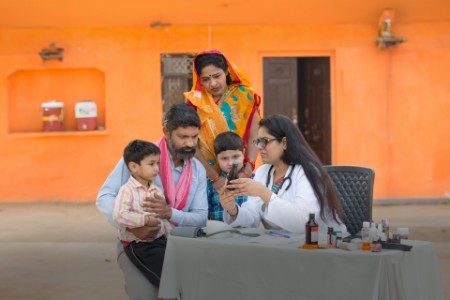Key achievements
Improving health indicators: The remarkable progress and achievement of National Health Policy targets of key health indicators such as infant mortality, maternal mortality and neonatal mortality rates is a testament to India's efforts in enhancing healthcare delivery and maternal and child health services. These improvements signify a brighter future for generations to come, with better health outcomes and reduced disparities.
Healthcare financing: India's recognition of the importance of healthcare funding is evident from the upward trend of healthcare expenditure as a percentage of GDP, reaching 2.1% in 2022-23 from 1.2% in 2014-15. This trend signifies a positive step towards fulfilling the recommendation of the Fifteenth Finance Commission, which proposed that public health expenditure of Union and State Governments together should be increased in a progressive manner to reach 2.5% of GDP by 2025.
Transforming healthcare infrastructure: The expansion of government hospitals, medical colleges, and healthcare infrastructure is a significant stride towards meeting the evolving healthcare demands of India's burgeoning population and lays the foundation for enhanced healthcare accessibility and delivery. The establishment and operationalization of more than 0.17 million Ayushman Arogya Mandirs in India represent a significant step towards enhancing access to comprehensive primary healthcare services across rural and urban areas. To broaden the reach of specialized medical services, particularly in underserved regions, 11 AIIMS have been established in the last decade. Additionally, five more AIIMS are planned to be established, which will add over 5,000 beds to the country’s healthcare infrastructure.
Strengthening the healthcare workforce: The surge in the number of medical colleges, nursing colleges, MBBS seats and PG medical seats addresses the critical need for a skilled workforce to cater to the growing healthcare demands. In the last two decades, the number of medical colleges has nearly tripled. Further, the government plans to establish 157 new nursing colleges in the country. This investment in human capital not only ensures quality care but also creates employment opportunities and fosters economic growth.
Leadership in the pharmaceutical industry: India's leadership in the global pharmaceutical industry, ranking third in production by volume, underscores its pivotal role in meeting global healthcare needs. India accounts for 60% of global vaccine production and manufactures about 60,000 different generic brands across 60 therapeutic categories, which is equivalent to 20% of the global supply of generics. The industry's contribution to driving the economic growth and supplying essential medicines worldwide highlights India's commitment to healthcare and pharmaceutical innovation and accessibility.
Attractiveness for medical value travel: India's status as an attractive destination for medical value travel speaks volumes about the quality of healthcare services and the effectiveness of healthcare branding initiatives. From 2012 to 2023, there has been a remarkable growth of approximately 10.32% CAGR in the number of medical tourists visiting India, reaching to more than 0.5 million medical tourists in 2023. This not only boosts India's reputation as a healthcare hub, but also stimulates medical tourism, contributing to economic development.
Embracing the digital health revolution: Initiatives like the Ayushman Bharat Digital Mission, CoWIN App, e-Sanjeevani, e-Hospital, etc. represent a paradigm shift in healthcare delivery, leveraging digital technologies to bridge gaps in the healthcare structure in India. These efforts extend healthcare facilities to every corner of the nation, empowering citizens with access to essential services and information.



